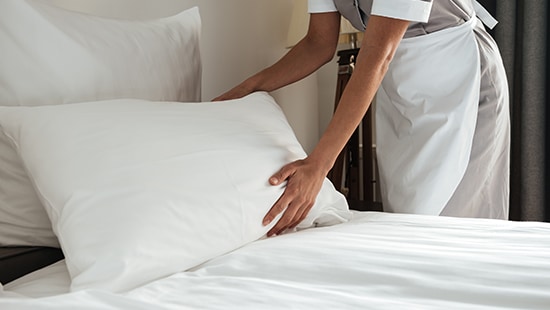A Better Strategy for Beating Bed Bugs
Pest Press Newsletter

As hotels gear up for increased travel, they’re facing a growing risk from pests that hitchhike on guest belongings. Bed bugs have had limited food sources thanks to the pandemic and are ready for their first meal after months of waiting. Meanwhile anxious guests are even more focused on the minute details of cleanliness, health and safety in hotel rooms. The costs of bed bug incidents are rising, as well: A study referenced by the National Institutes of Health found that a single bed bug incident can cost up to $6,000 in treatment, furniture replacement and lost revenue. If it goes viral on social media or review sites, a single incident can decrease room rates by $38 per night. Half of all hotels have now faced bed bug-related litigation, with an NIH referenced study finding average costs around $20,000.
Hotel operators are on the lookout for new innovations and better strategies for beating bed bugs. But the reality is that there are no shortcuts; there are many tools in the bed bug mitigation toolkit, and each has its strengths and challenges. Science-based best practices uses an integrated approach, featuring a three-pronged strategy of inspection, treatment and prevention:
Inspection
Visual inspection by housekeeping staff is simple, cost-effective, and a good component of a front-line defense. In recent years, canine inspections have increased in popularity but canine inspection is not discreet; often has inconsistent results. In order to make visual inspections more effective, hotels need to continuously train staff on how to spot the signs of all bed bugs life stages (which can easily be seen) as well as where to look. It’s not just the mattress — the headboard, box spring, carpeting and upholstered furniture can all harbor bed bugs.
Treatment
Rapidly and effectively eliminating bed bugs is critical to reduce the chance of spreading the infestation to other areas. While treatment technologies have certainly advanced in recent years, there is no one-size-fits-all solution. Chemical and biochemical products can be applied as “spot treatments,” but can be damaging on certain surfaces, do not provide comprehensive elimination, and are limited by regulatory restrictions in some regions. Non-chemical treatments like heat remain the most reliable means of comprehensive bed bug elimination. However, these treatments can be costly, conspicuous, and require an experienced professional to execute. All of this means that the right treatment for a given incident is highly dependent on the size of the infestation, the risk of the spread, the specifics of room furniture and materials, and your local regulatory requirements.
Prevention
While hotels cannot prevent bed bugs from being introduced, as incoming guests and their personal belongings are the primary sources of infestations, there are tools and tactics that can be used to proactively mitigate bed bug risk. As the old adage goes: “An ounce of prevention is worth a pound of cure.” Mattress encasements can provide protection for some of the biggest investments in the room — by helping to reduce the need for replacement and getting impacted rooms back online faster. Choose wisely — some brands of encasements are ineffective and easily damaged — and know that bed bugs can still infest headboards, carpeting and upholstered furniture. Routine inspections and residual treatments provide another layer of proactive protection against bed bugs. Leading pest management providers are now using data-driven strategies and digital tools to ensure rooms are treated at the proper interval, optimizing room rotation to minimize the impact on room availability.
The silver bullet for bed bugs (doesn’t exist)
As hotel operators gear up for increased travel and anxious guests with heightened cleanliness concerns, now is the time to re-examine their bed bug programs. There is no single solution or “silver bullet” for beating bed bugs. Rather, hotels need to make sure they have the right tools and tactics in place across three different pillars: finding bed bugs before guests do, rapidly and effectively eliminating bed bugs when they do appear, and proactively mitigating risk wherever possible.
Learn more about how to build a comprehensive bed bug strategy by reading the Ecolab eBook:
A Better Way to Beat Bed Bugs: Why Every Hotel Needs a 3-Pronged Bed Bug Strategy


